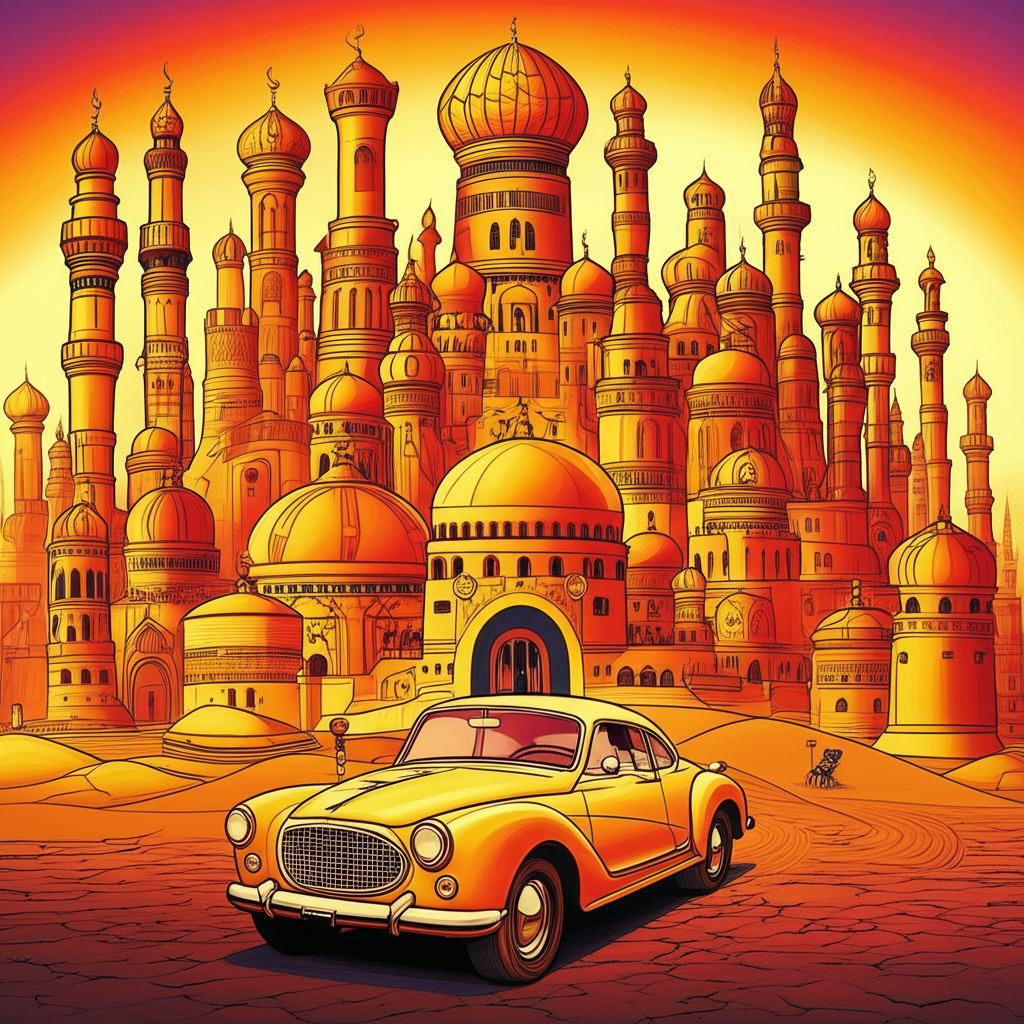
The vast, sun-scorched landscapes of the Arabian Peninsula, a realm of stark beauty and profound silence, have long been a crucible for stories. Among these ancient narratives, woven from the threads of human experience and the mysteries of the natural world, are tales of formidable beings and mythical places. One such legend, deeply rooted in the folklore that circulated among the peoples of the region, speaks of the "City of Brass" and its purported connection to the origins of Mount Sinai. It is crucial to understand that these are traditional stories, passed down through generations, offering glimpses into the worldview of ancient peoples, not factual accounts or divine revelations.
The genesis of such myths can often be traced to a time when the cosmos was a more immediate and potent presence in the lives of humanity. In the era when these tales likely took shape, the world was perceived as a place brimming with unseen forces, where natural phenomena were imbued with intent and where the boundaries between the earthly and the supernatural were fluid. The harsh realities of desert life – the unforgiving sun, the sudden sandstorms, the scarcity of water, and the sheer, awe-inspiring scale of the mountains – would have naturally fostered a rich tapestry of imagination and spiritual reflection. For these ancient peoples, the world was a dynamic stage upon which divine powers, benevolent or fearsome, played out their dramas, and the land itself held secrets waiting to be deciphered through stories and lore.
Within this rich cultural soil, the concept of the "City of Brass" emerged as a potent symbol. While not a singular, universally defined entity in all folklore, the City of Brass often represented an ultimate, unyielding, and often inaccessible place of power, wealth, or even divine punishment. It was a city forged not from earthly stone but from the unyielding, gleaming metal that could withstand the fiercest desert winds and the most scorching sun. This material itself carried symbolic weight, suggesting permanence, perhaps even a kind of infernal permanence, given its association with intense heat and the transformative, destructive power of fire. It was a testament to human ambition pushed to its limits, or perhaps a cautionary tale of hubris, a place where immense power resided, guarded by formidable beings.
The narrative connecting this mythical city to Sinai, the mountain held sacred in Abrahamic traditions, often takes a dramatically imaginative turn. Imagine a time when the very foundations of the earth were still settling, when the divine was more palpably felt in the physical world. According to some of these ancient tales, the origins of Sinai are not merely geological but are intertwined with the fiery creation of the City of Brass. The story suggests that in the primordial stages of existence, before the current order of the world, a powerful, elemental force, often depicted as a djinn or a formidable entity born of smoke and fire, sought to forge a city of unparalleled magnificence and power. This entity, driven by ambition or a desire to manifest its potent essence, gathered the fiercest fires and the most unyielding metals from the very heart of the earth.
The process of its creation was one of immense, cataclysmic energy. The story unfolds with vivid imagery of molten metal, incandescent flames, and earth-shattering tremors. As this being toiled, shaping the infernal city, the very ground beneath it convulsed. The sheer intensity of the divine or elemental energies unleashed during the forging of the City of Brass caused the earth to buckle and rise. It is said that Mount Sinai itself was not born of slow geological processes but was a direct consequence, a towering monument to the residual power and heat left behind by this celestial act of creation. Some tales even posit that the mountain’s very composition, its ruggedness and the deep fissures that scar its surface, are echoes of the fiery crucible from which the City of Brass was brought forth. The mountain, in this telling, became a testament to the raw, untamed forces that shaped the early world, a physical manifestation of the power that once birthed the mythical city.
The symbolism inherent in these narratives is multifaceted and speaks volumes about the ancient mindset. The City of Brass, with its unyielding metal and association with fire, could represent the awe-inspiring, yet potentially dangerous, power of nature. It might have symbolized the immense, untamed forces that ancient peoples grappled with, from the scorching desert sun to volcanic upheavals. The act of its creation, and its subsequent link to Sinai, could also reflect a deep-seated human need to understand the origins of sacred places. Sinai, as a mountain of divine revelation, would have held profound significance, and linking its formation to a powerful, albeit mythical, act of creation would have lent it an even deeper, more primordial aura. Furthermore, the story might have served as a cautionary tale, a reminder of the potential for destructive power when ambition or elemental forces are unchecked. The djinn or entity behind the City of Brass could represent the temptations of pride and the pursuit of power that could lead to ruin, even if that ruin manifested as a divinely significant mountain.
In contemporary times, these ancient myths continue to resonate, finding new life in literature, film, and video games. The "City of Brass" has become a recurring motif in fantasy settings, often depicted as a lost civilization, a powerful nexus of magic, or a treasure trove guarded by formidable Djinn. Its visual imagery – the gleaming brass, the searing heat, the labyrinthine architecture – continues to capture the imagination. Similarly, the mystique surrounding Mount Sinai, a place of profound spiritual significance in multiple religions, is often enhanced by the echoes of these older, more primal origin stories that explore its geological and perhaps even supernatural beginnings. Cultural studies scholars examine these narratives as invaluable windows into the belief systems, anxieties, and creative expressions of ancient societies.
It is paramount to reiterate that the City of Brass and its purported connection to the origins of Sinai are fascinating cultural stories, products of human imagination and attempts to comprehend the world through narrative. As Muslims, we recognize that the true Creator and Sustainer of all existence is Allah alone. These traditional tales, while rich in cultural heritage and imaginative power, do not alter this fundamental truth. They serve as a testament to the enduring human impulse to create stories, to explain the inexplicable, and to imbue the world around us with meaning. They remind us of the vibrant tapestry of human storytelling and the enduring power of myth to shape our understanding of history, culture, and the boundless reach of our own imaginations.





